NVIDIA and SoftBank Corp. today announced they are collaborating on a pioneering platform for generative AI and 5G/6G applications that is based on the NVIDIA GH200 Grace Hopper™ Superchip and which SoftBank plans to roll out at new, distributed AI data centers across Japan.
NVIDIA and WPP today announced they are developing a content engine that harnesses NVIDIA Omniverse™ and AI to enable creative teams to produce high-quality commercial content faster, more efficiently and at scale while staying fully aligned with a client’s brand.
How do you help robots build better robots? By simulating even more robots. NVIDIA founder and CEO Jensen Huang today showcased how leading electronics manufacturer Quanta is using AI-enabled robots to inspect the quality of its products. In his keynote speech at this week’s COMPUTEX trade show in Taipei, Huang presented a video demonstrating how Read article >
NVIDIA today announced that electronics manufacturers worldwide are advancing their industrial digitalization efforts using a new, comprehensive reference workflow that combines NVIDIA technologies for generative AI, 3D collaboration, simulation and autonomous machines.
In his first live keynote since the pandemic, NVIDIA founder and CEO Jensen Huang today kicked off the COMPUTEX conference in Taipei, announcing platforms that companies can use to ride a historic wave of generative AI that’s transforming industries from advertising to manufacturing to telecom. Speaking to a packed house of some 3,500, he described Read article >
MediaTek, a leading innovator in connectivity and multimedia, is teaming with NVIDIA to bring drivers and passengers new experiences inside the car. The partnership was announced today at a COMPUTEX press conference with MediaTek CEO Rick Tsai and NVIDIA founder and CEO Jensen Huang. “NVIDIA is a world-renowned pioneer and industry leader in AI and Read article >
New 14-inch NVIDIA Studio laptops, equipped with GeForce RTX 40 Series Laptop GPUs, give creators peak portability with a significant increase in performance over the last generation.
 Simulation is an essential tool for robots learning new skills. These skills include perception (understanding the world from camera images), planning…
Simulation is an essential tool for robots learning new skills. These skills include perception (understanding the world from camera images), planning…
Simulation is an essential tool for robots learning new skills. These skills include perception (understanding the world from camera images), planning (formulating a sequence of actions to solve a problem), and control (generating motor commands to change a robot’s position and orientation).
Robotic assembly is ubiquitous in the automotive, aerospace, electronics, and medical device industries. Setting up robots to perform an assembly task is a time-consuming and expensive process, requiring a team to engineer the robot’s trajectories and constrain its surroundings carefully.
In other areas of robotics, simulation has become an indispensable tool, especially for the development of AI. However, robotic assembly involves high-precision contact between geometrically complex, tight-tolerance parts. Simulating these contact-rich interactions has long been viewed as computationally intractable.
With recent developments from NVIDIA advancing robotic assembly, faster-than-realtime simulation is possible. These high-speed simulations enable the use of powerful, state-of-the-art techniques in reinforcement learning (RL). With RL, virtual robots explore simulated environments, gain years of experience, and learn useful skills through intelligent trial-and-error. Using RL for robotic assembly minimizes the need for human expertise, increases robustness to variation, and reduces hardware wear and tear. The term sim-to-real refers to the transfer of skills from simulation to the real world.
One of the biggest challenges in using RL for robotic assembly is that skills learned by robots in simulation do not typically transfer well to real-world robots. Subtle discrepancies in physics, motor signals, and sensor signals between the simulator and the real world cause this issue. Moreover, a real-world robot might encounter scenarios never seen in the simulator. These issues are collectively known as the reality gap.
What is IndustReal?
To use RL for challenging assembly tasks and address the reality gap, we developed IndustReal. IndustReal is a set of algorithms, systems, and tools for robots to solve assembly tasks in simulation and transfer these capabilities to the real world.
IndustReal’s primary contributions include:
- A set of algorithms for simulated robots to solve complex assembly tasks with RL.
- A method that addresses the reality gap and stabilizes the learned skills when deployed in the real world.
- A real-world robotic system that performs sim-to-real transfer of simulation-trained assembly skills from end-to-end.
- A hardware and software toolkit for researchers and engineers to reproduce the system.
- IndustRealKit is a set of 3D-printable CAD models of assets inspired by NIST Task Board 1, the established benchmark for robotic assembly.
- IndustRealLib is a lightweight Python library that deploys skills learned in the NVIDIA Isaac Gym simulator onto a real-world Franka Emika Panda robot arm.

Training algorithms and deployment method
In this work, we propose three algorithms to help learn assembly skills using RL in simulation. We also propose a deployment method for executing the skills on a real-world robot.
Simulation-aware policy update
Robotics simulators like NVIDIA Isaac Gym and NVIDIA Isaac Sim simulate real-world physics while simultaneously satisfying many physical constraints–most importantly, that objects cannot overlap with one another, or, interpenetrate. In most simulators, small interpenetrations between objects are unavoidable, especially when executing in real time.
We introduce the simulation-aware policy update (SAPU) that provides the simulated robot with knowledge of when simulation predictions are reliable or unreliable. Specifically, in SAPU, we implement a GPU-based module in NVIDIA Warp that checks for interpenetrations as the robot is learning how to assemble parts using RL.
We weight the robot’s simulated experience more when interpenetrations are small, and less when interpenetrations are large. This strategy prevents a simulated robot from exploiting inaccurate physics to solve tasks, which would cause it to learn skills that are unlikely to transfer to the real world.
Signed distance field reward
To solve tasks with RL, a reward signal (such as measuring how much progress the robot has made on solving the task) must be defined. However, it is challenging to define a reward signal for the alignment of geometrically complex parts during an assembly process.
We introduce a signed distance field (SDF) reward to measure how closely simulated parts are aligned during the assembly process. An SDF is a mathematical function that can take points on one object and compute the shortest distances to the surface of another object. It provides a natural and general way to describe alignment between parts, even when they are highly symmetric or asymmetric.
In the SDF reward, we define our reward signal as the SDF distance between the current position and the target position of a part during the assembly process.
Sampling-based curriculum
Curriculum learning is an established approach in RL for solving problems that involve many individual steps or motions; as the robot learns, the difficulty of the task is gradually increased.
In our assembly tasks, the robot begins by solving simple assembly problems (that is, where the parts are partially assembled), before progressing to harder problems (that is, where the parts are disassembled).
As the initial engagement between parts is gradually reduced, there comes a point where the parts no longer begin in contact. This sudden increase in difficulty can lead to a performance collapse as the robot’s knowledge has become too specialized towards the partially assembled configurations.
We introduce a sampling-based curriculum (SBC) for a simulated robot to learn a complex assembly task gradually. We ask the robot to solve assembly problems sampled across the entire difficulty range during all stages of the curriculum. However, we gradually remove the easiest problems from the problem distribution. At the final stage of the curriculum, the parts never begin in contact. See the following visualization.

Policy-level action integrator
In the most common applications of RL to robotics, the robot generates actions that are incremental adjustments to its pose (that is, its position and orientation). These increments are applied to the robot’s current pose to produce an instantaneous target pose. With real-world robots, this strategy can lead to discrepancies between the robot’s final pose and its final target pose due to the complexities of the physical robot.
We also propose a policy-level action integrator (PLAI), a simple algorithm that reduces steady-state (that is, long-term) errors when deploying a learned skill on a real-world robot. We apply the incremental adjustments to the previous instantaneous target pose to produce the new instantaneous target pose.
Mathematically (akin to the integral term of a classical PID controller), this strategy generates an instantaneous target pose that is the sum of the initial pose and the actions generated by the robot over time. This technique can minimize errors between the robot’s final pose and its final target pose, even in the presence of physical complexities.
We compare the performance of a standard (nominal) strategy, our PLAI algorithm, and a classical PID controller on a reach task, where the robot is trying to move to a target position. See the following visualization.
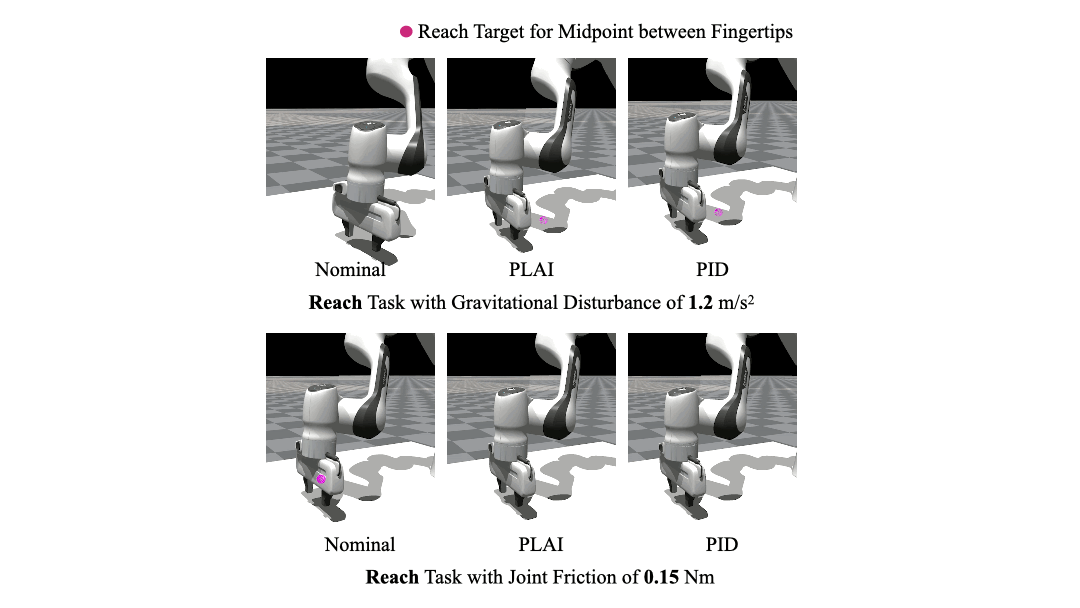
Systems and tools
The setup used for the real-world experiments conducted in IndustReal includes a Franka Emika Panda robot arm with an Intel RealSense D435 camera mounted on its hand and an assembly platform with parts.
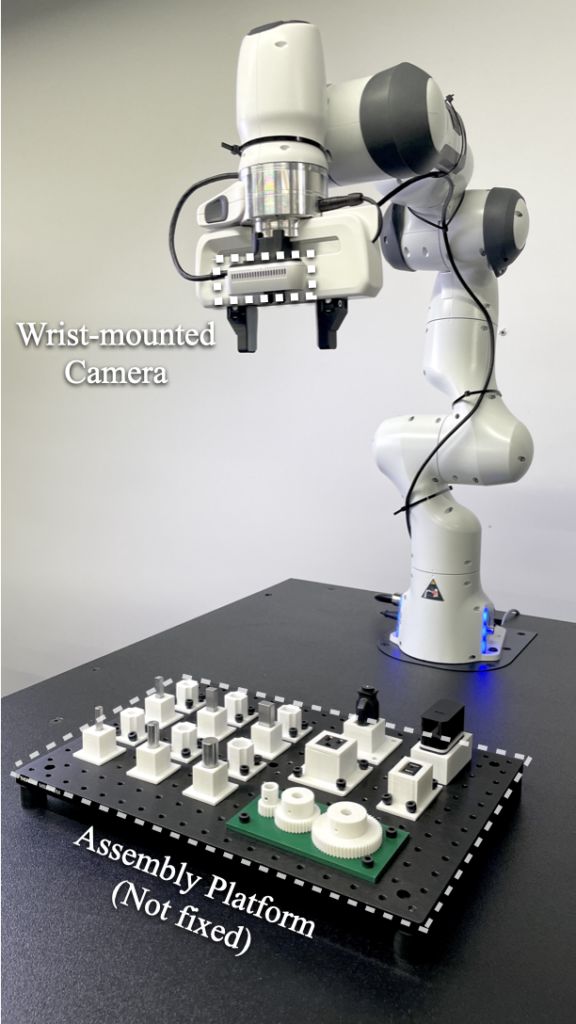
IndustReal provides hardware (IndustRealKit) and software (IndustRealLib) for reproducing the system presented in the paper.
IndustRealKit contains 3D-printable 20-part CAD models for all parts used in this work. The models come with six peg holders, six peg sockets, three gears, one gear base (with three gear shafts), and four NEMA connectors and receptacle holders, which are standard plugs and power outlets used in the United States.
The purchasing list includes 17 parts: six metal pegs (from the NIST benchmark), four NEMA connectors and receptacles, one optical platform, and fasteners.
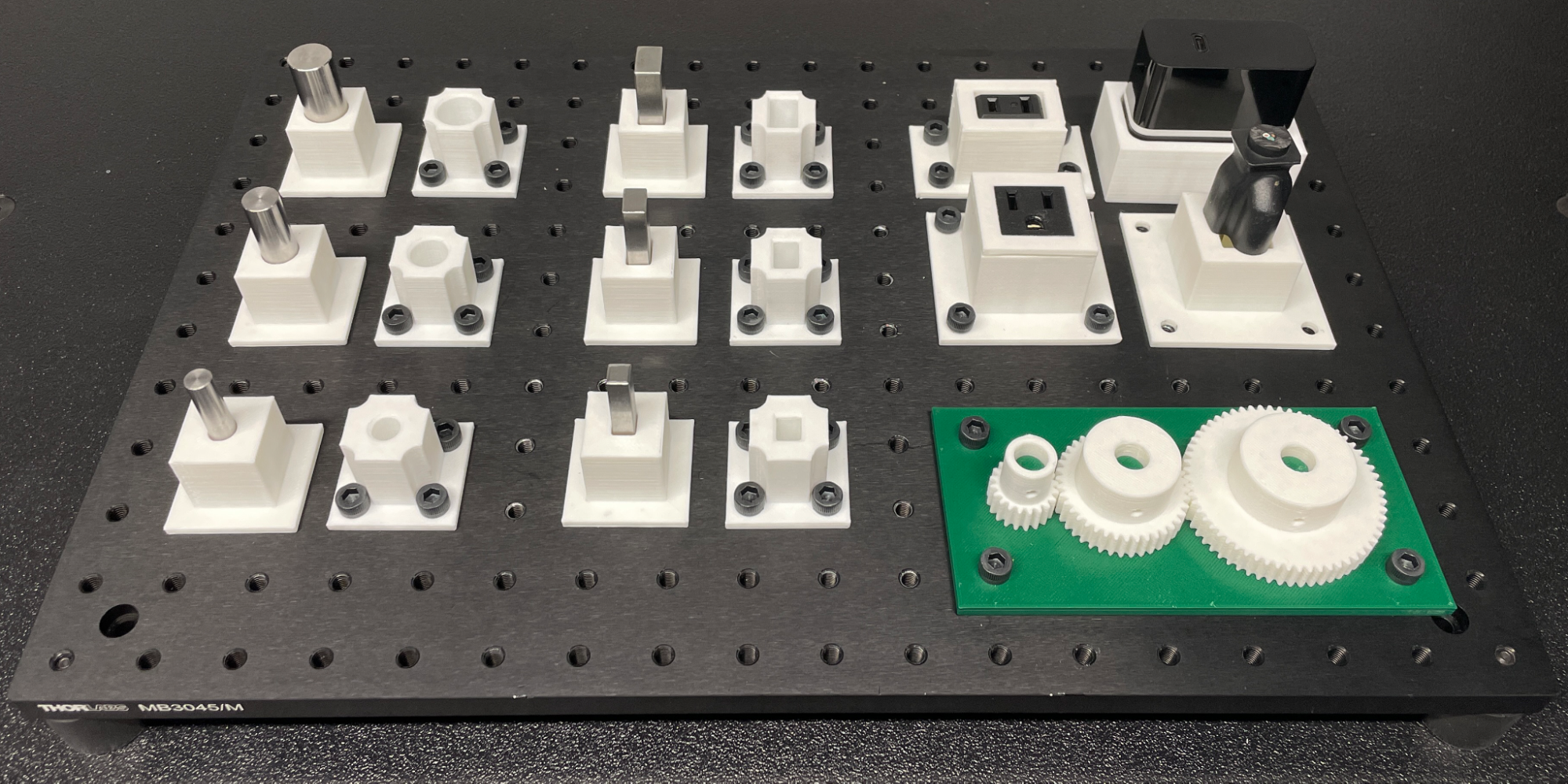
IndustRealLib is a lightweight library containing code for deploying skills learned in simulation through RL onto a real-world robot arm. Specifically, we provide scripts for users to deploy control policies (that is, neural networks that map sensor signals to robot actions) trained in the NVIDIA Isaac Gym simulator onto a Franka Emika Panda robot quickly.
Future direction
IndustReal shows a path toward leveraging the full potential of simulation in robotic assembly tasks. As simulation becomes more accurate and efficient, and additional sim-to-real transfer techniques are developed, we foresee numerous possibilities of expanding this work to other tasks in manufacturing (such as screw fastening, cable routing, and welding). It is reasonable to believe that one day every advanced industrial manufacturing robot will be trained in simulation using such techniques, for seamless and scalable transfer to the real world.
Our next steps are to expand the system to include more objects, assembly tasks, and complex environments. We also aim to develop additional sim-to-real techniques for the smooth transfer of learned skills at lower cost, higher reliability, and guaranteed safety.
Get started with IndustReal
- Visit the IndustReal project page, for links to the paper and summary videos. Stay tuned for the upcoming availability of IndustRealKit and IndustRealLib.
- Download the standalone NVIDIA Isaac Gym Preview Release and NVIDIA Isaac Gym Environments. This includes the NVIDIA Omniverse factory environments that were the basis for training the assembly skills in IndustReal.
- Download the next-generation NVIDIA Isaac Sim powered by Omniverse.
Paper authors Bingjie Tang, Michael A. Lin, Iretiayo Akinola, Ankur Handa, Gaurav S. Sukhatme, Fabio Ramos, Dieter Fox, and Yashraj Narang will present their research “IndustReal: Transferring Industrial Assembly Tasks from Simulation to Reality” at the Robotics: Science and Systems (RSS) conference in July 2023.
Getting Started with NVIDIA NVUE API
 Learn how NVIDIA NVUE API automates data center network operations with sample code for Curl commands, Python Code, and NVUE CLI.
Learn how NVIDIA NVUE API automates data center network operations with sample code for Curl commands, Python Code, and NVUE CLI.
Learn how NVIDIA NVUE API automates data center network operations with sample code for Curl commands, Python Code, and NVUE CLI.
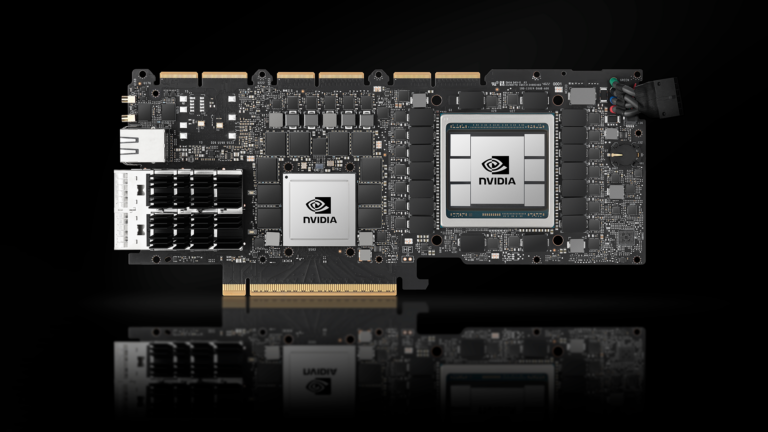 The pace of 5G investment and adoption is accelerating. According to the GSMA Mobile Economy 2023 report, nearly $1.4 trillion will be spent on 5G CAPEX,…
The pace of 5G investment and adoption is accelerating. According to the GSMA Mobile Economy 2023 report, nearly $1.4 trillion will be spent on 5G CAPEX,…
The pace of 5G investment and adoption is accelerating. According to the GSMA Mobile Economy 2023 report, nearly $1.4 trillion will be spent on 5G CAPEX, between 2023 and 2030. Radio access network (RAN) may account for over 60% of the spend.
Increasingly, the CAPEX spend is moving from the traditional approach with proprietary hardware, to virtualized RAN (vRAN) and Open RAN architectures that can benefit from cloud economics and do not require dedicated hardware. Despite these benefits, Open RAN adoption is struggling because existing technology has yet to deliver the benefits of cloud economics, and cannot deliver high performance and flexibility at the same time.
NVIDIA has overcome these challenges with the NVIDIA AX800 converged accelerator, delivering a truly cloud-native and high-performance accelerated 5G solution on commodity hardware that can run on any cloud (Figure 1).
To benefit from cloud economics, the future of the RAN is in the cloud (RAN-in-the-Cloud). The road to cloud economics aligns with Clayton Christensen’s characterization of disruptive innovation in traditional industries as presented in his book, The Innovator’s Dilemma: When New Technologies Cause Great Firms to Fail. That is, with progressive incremental improvements, new and seemingly inferior products are able to eventually capture market share.
Existing Open RAN solutions currently cannot support non-5G workloads and still deliver inferior 5G performance. They are mostly still using single-use hardware accelerators. This limits their appeal to telecom executives, as the comparative performance of traditional solutions delivers a tried-and-tested deployment plan for 5G.
However, the NVIDIA Accelerated 5G RAN solution based on NVIDIA AX800 has overcome these limitations and is now delivering comparable performance to traditional 5G solutions. This paves the way to deploy 5G Open RAN on commercial-off-the-shelf (COTS) hardware at any public cloud or telco edge.
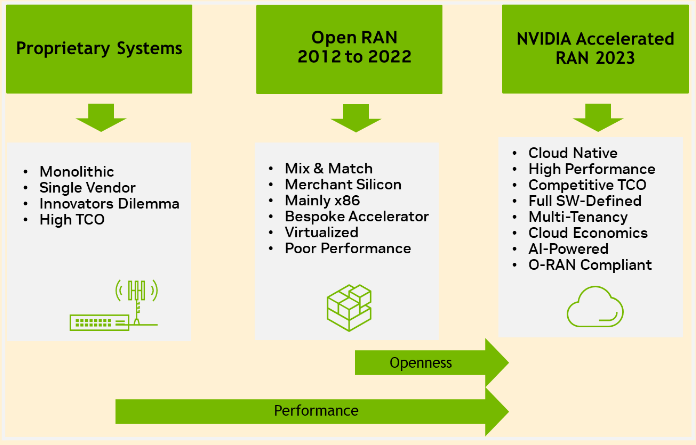
Solutions to support cloud-native RAN
To drive broad adoption of cloud-native RAN, the industry needs solutions that are cloud native, deliver high RAN performance, and are built with AI capability.
Cloud native
This approach delivers better utilization, multi-use and multi-tenancy, lower TCO, and increased automation—with all the virtues of cloud computing and benefiting from cloud economics.
A cloud-native network that benefits from cloud economics requires a complete rethink in approach to deliver a network that is 100% software-defined, deployed on general-purpose hardware and can support multi-tenancy. As such, it is not about building bespoke and dedicated systems in the public or telco cloud managed by Cloud Service Providers (CSPs).
High RAN performance
High RAN performance is required to deliver new technology—such as massive MIMO with its improved spectral efficiency, cell density, and higher throughput—all with improved energy efficiency. Achieving high performance on commodity hardware that is comparable to the performance of dedicated systems is proving a formidable challenge. This is due to the death of Moore’s Law and the relatively low performance achieved by software running on CPUs.
As a result, RAN vendors are building fixed-function accelerators to improve the CPU performance. This approach leads to inflexible solutions and does not meet the flexibility and openness expectations for Open RAN. In addition, with fixed-function or single-use accelerators, the benefits of cloud economics cannot be achieved.
For example, software-defined 5G networks that are based on Open RAN specifications and COTS hardware are achieving typical peak throughput of ~10 Gbps compared to >30 Gbps peak throughput performance on 5G networks that are built in the traditional, vertically integrated, appliance approach using bespoke software and hardware.
According to a recent survey of 52 telco executives reported in Telecom Networks: Tracking the Coming xRAN Revolution, “In terms of obstacles to xRAN deployment, 62% of operators voice concerns regarding xRAN performance today relative to traditional RAN.”
AI capability
Solutions must evolve from the current application, based on proprietary implementation in the telecom network, toward an AI-capable infrastructure for hosting internal and external applications. AI plays a role in 5G (AI-for-5G) to automate and improve system performance. Likewise, AI plays a role, together with 5G (AI-on-5G), to enable new features in 5G and beyond.
Achieving these goals requires a new architectural approach for cloud-native RAN, especially with a general-purpose COTS-based accelerated computing platform. This is the NVIDIA focus, as summarized in Figure 2.
The emphasis is on delivering a general-purpose COTS server built with NVIDIA converged accelerators (such as the NVIDIA AX800) that can support high-performance 5G and AI workloads on the same platform. This will deliver cloud economics with better utilization and reduced TCO, and a platform that can efficiently run AI workloads to future proof the RAN for the 6G era.
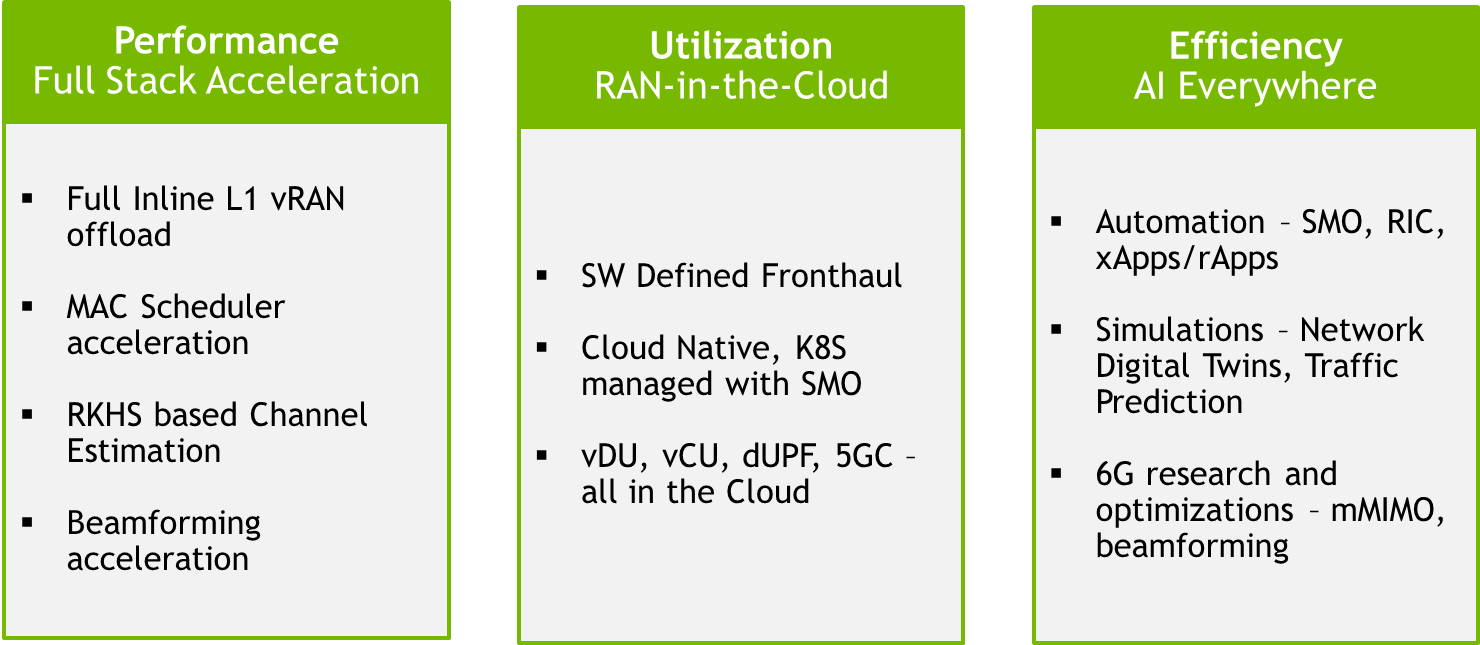
Run 5G and AI workloads on the same accelerator with NVIDIA AX800
The NVIDIA AX800 converged accelerator is a game changer for CSPs and telcos because it brings cloud economics into the operations and management of telecom networks. The AX800 supports multi-use and multi-tenancy of both 5G and AI workloads on commodity hardware, that can run on any cloud, by dynamically scaling the workloads. In doing so, it enables CSPs and telcos to use the same infrastructure for both 5G and AI with high utilization levels.
Dynamic scaling for multi-tenancy
The NVIDIA AX800 achieves dynamic scaling, both at the data center and at the server and card levels, enabling support of 5G and AI workloads. This scalable, flexible, energy-efficient, and cost-effective approach can deliver a variety of applications and services.
At the data center and server levels, the NVIDIA AX800 supports dynamic scaling. The Open RAN service and management orchestration (SMO) is able to allocate and reallocate computational resources in real time to support either 5G or AI workloads.
At the card level, NVIDIA AX800 supports dynamic scaling using NVIDIA Multi-Instance GPU (MIG), as shown in Figure 3. MIG enables concurrent processing of virtualized 5G base stations and edge AI applications on pooled GPU hardware resources. This enables each function to run on the same server and accelerator in a coherent and energy-conscientious manner.
This novel approach provides increased radio capacity and processing power, contributing to better performance and enabling peak data throughput processing with room for future antenna technology advancements.

Commercial implications of dynamic scaling for multi-tenancy
The rationale for pooling 5G RAN in the cloud (RAN-in-the-Cloud) is straightforward. The RAN constitutes the largest CAPEX and OPEX spending for telcos (>60%). Yet the RAN is also the most underutilized resource, with most radio base stations typically operating below 50%.
Moving RAN compute into the cloud brings all the benefits of cloud computing: pooling and higher utilization in a shared cloud infrastructure resulting in the largest CAPEX and OPEX reduction for telcos. It also supports cloud-native scale in scale out and dynamic resource management.
Dynamic scaling for multi-tenancy is commercially significant in three ways. First, it enables deployment of 5G and AI on general-purpose computing hardware, paving the way to run the 5G RAN on any cloud, whether on the public cloud or the telco edge cloud (telco base station). As all general computing workloads migrate to the cloud, it is clear that the future of the RAN will also be in the cloud. NVIDIA is a leading industry voice to realize this vision, as detailed in RAN-in-the-Cloud: Delivering Cloud Economics to 5G RAN.
Second, dynamic scaling leverages cloud economics to deliver ROI improvements to telecom networks. Instead of the typical TCO challenges with single-use solutions, multi-tenancy enables the same infrastructure to be used for multiple workloads, hence increasing utilization.
Telcos and enterprises are already using the cloud for mixed workloads, which are spike-sensitive, expensive, and consist of many one-off “islands.” Likewise, telcos and enterprises are increasingly using NVIDIA GPU servers to accelerate edge AI applications. The NVIDIA AX800 provides an easy path to use the same GPU resources for accelerating the 5G RAN connectivity, in addition to edge AI applications.
Third, the opportunity for dynamic scaling using NVIDIA AX800 provides marginal utility to telcos and CSPs who are already investing in NVIDIA systems and solutions to power their AI (especially generative AI) services.
Current demand for NVIDIA compute, especially to support generative AI applications, is significantly high. As such, once the investment is made, deriving additional marginal utility from running 5G and generative AI applications together massively accelerates the ROI on NVIDIA accelerated compute.

NVIDIA AX800 delivers performance improvements for software-defined 5G
The NVIDIA AX800 converged accelerator delivers 36 Gbps throughput on a 2U server, when running NVIDIA Aerial 5G vRAN, substantially improving the performance for a software-defined, commercially available Open RAN 5G solution.
This is a significant performance improvement over the typical peak throughput of ~10 Gbps of existing Open RAN solutions. It compares favorably with the >30 Gbps peak throughput performance on 5G networks that are built in the traditional way. It achieves this today by accelerating the physical layer 1 (L1) stack in the NVIDIA Aerial 5G vRAN (Figure 5). Further performance breakthroughs are in the pipeline as the NVIDIA AX800 can be leveraged for the full 5G stack in the near future (Figure 6).
The NVIDIA AX800 converged accelerator combines NVIDIA Ampere architecture GPU technology with the NVIDIA BlueField-3 DPU. It has nearly 1 TB/s of GPU memory bandwidth and can be partitioned into as many as seven GPU instances. NVIDIA BlueField-3 supports 256 threads, making the NVIDIA AX800 capable of high performance on the most demanding I/O-intensive workloads, such as L1 5G vRAN.
NVIDIA AX800 with NVIDIA Aerial together deliver this performance for 10 peak 4T4R cells on TDD at 100 MHz using four downlink (DL) and two uplink (UL) layers and 100% physical resource block (PRB) utilization. This enables the system to achieve 36.56 Gbps and 4.794 Gbps DL and UL throughput, respectively.
The NVIDIA solution is also highly scalable and can support from 2T2R (sub 1 GHz macro deployments) to 64T64R (massive MIMO deployments) configurations. Massive MIMO workloads with high layer counts are dominated by the computational complexity of algorithms for estimating and responding to channel conditions (for example, sounding reference signal channel estimator, channel equalizer, beamforming, and more).
The GPU, and specifically the AX800 (with the highest streaming multiprocessor count for NVIDIA Ampere architecture GPUs), offers the ideal solution to tackle the complexity of massive MIMO workloads at moderate power envelopes.
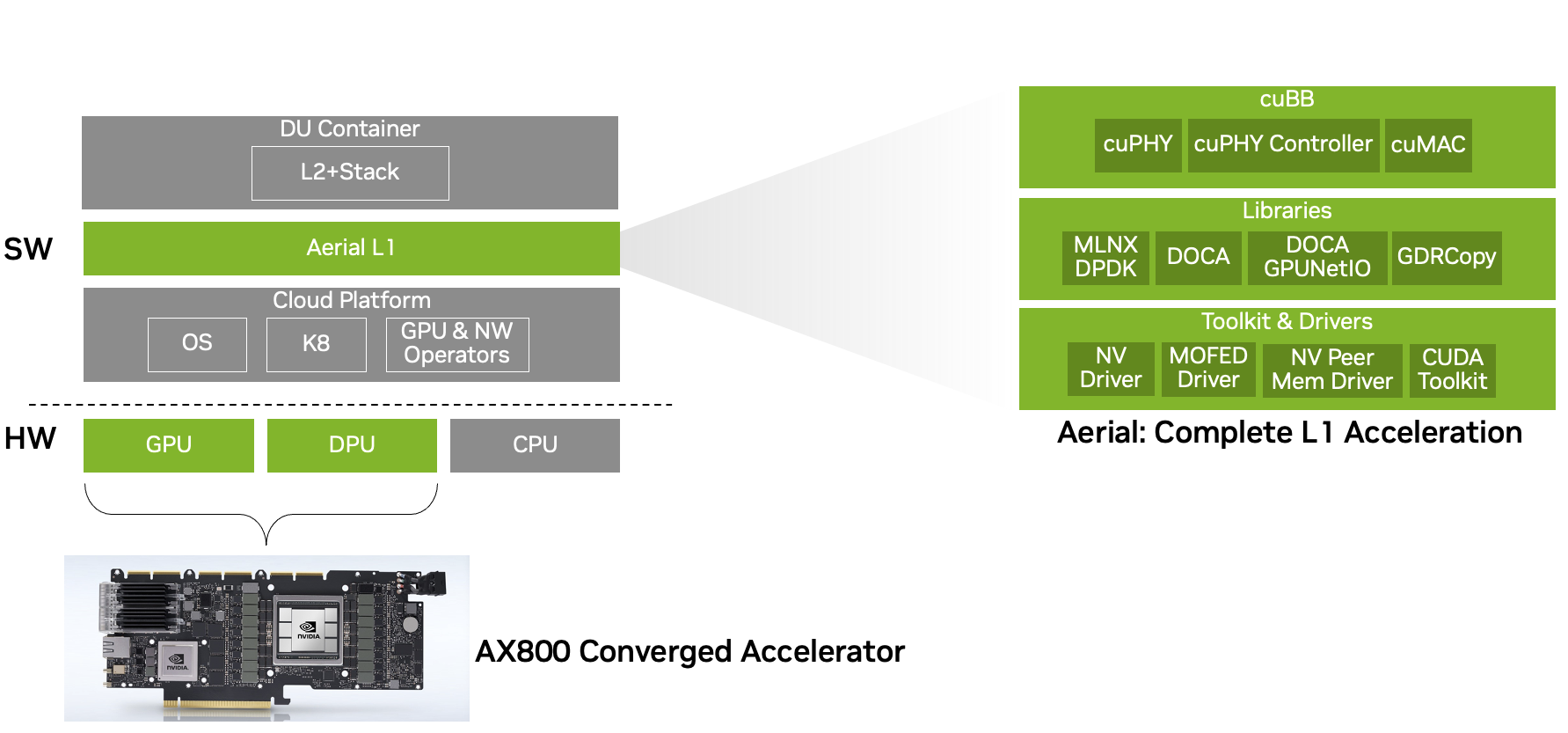
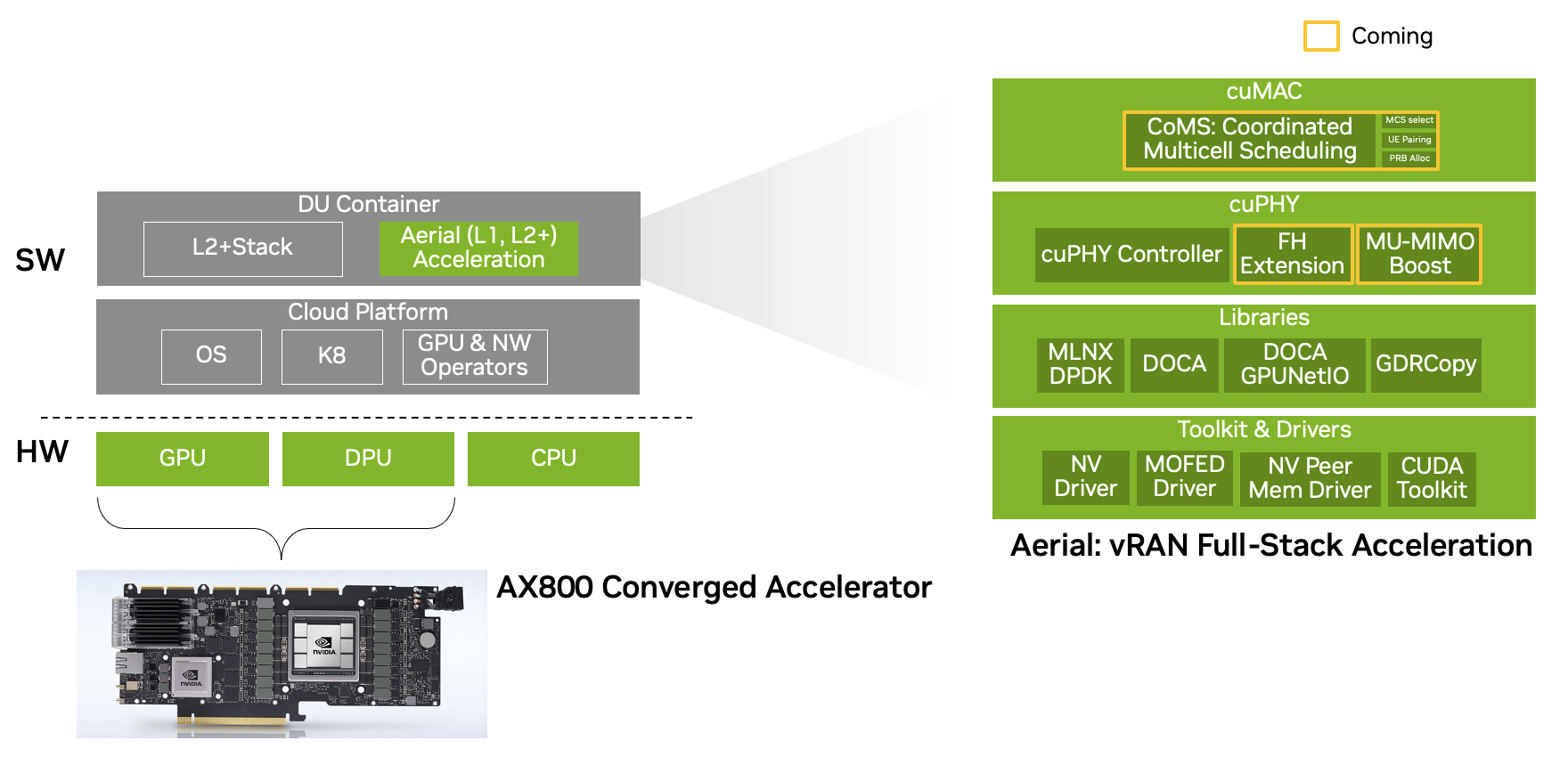
Summary
The NVIDIA AX800 converged accelerator offers a new architectural approach to deploying 5G on commodity hardware on any cloud. It delivers a throughput performance improvement of 36 Gbps for software-defined 5G using the NVIDIA Aerial 5G vRAN stack.
NVIDIA AX800 brings the vision of the RAN-in-the-Cloud closer to reality, offering telcos and CSPs a roadmap to move 5G RAN workloads into any cloud. There they can be dynamically combined with other AI workloads to improve infrastructure utilization, optimize TCO, and boost ROI. Likewise, the throughput improvement dramatically boosts the performance of Open RAN solutions, making them competitive with traditional 5G RAN options.
NVIDIA is working with CSPs, telcos, and OEMs to deploy the NVIDIA AX800 in commercial 5G networks. For more information, visit AI Solutions for Telecom.
